check engine Citroen DS4 RHD 2013.5 1.G Owner's Guide
[x] Cancel search | Manufacturer: CITROEN, Model Year: 2013.5, Model line: DS4 RHD, Model: Citroen DS4 RHD 2013.5 1.GPages: 400, PDF Size: 31.86 MB
Page 239 of 400
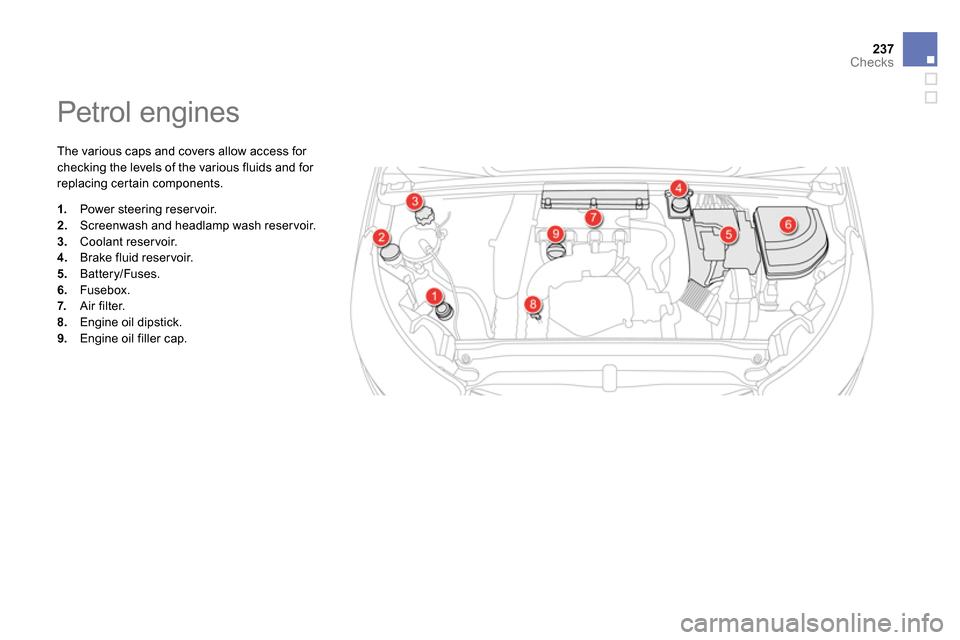
237Checks
Petrol engines
The various caps and covers allow access for
checking the levels of the various fluids and for
replacing certain components.
1.
Power steering reservoir.
2.
Screenwash and headlamp wash reser voir.
3.
Coolant reservoir.
4.
Brake fluid reser voir.
5.
Battery/Fuses.
6.
Fusebox.
7.
Air filter.
8.
Engine oil dipstick.
9.
Engine oil filler cap.
Page 240 of 400
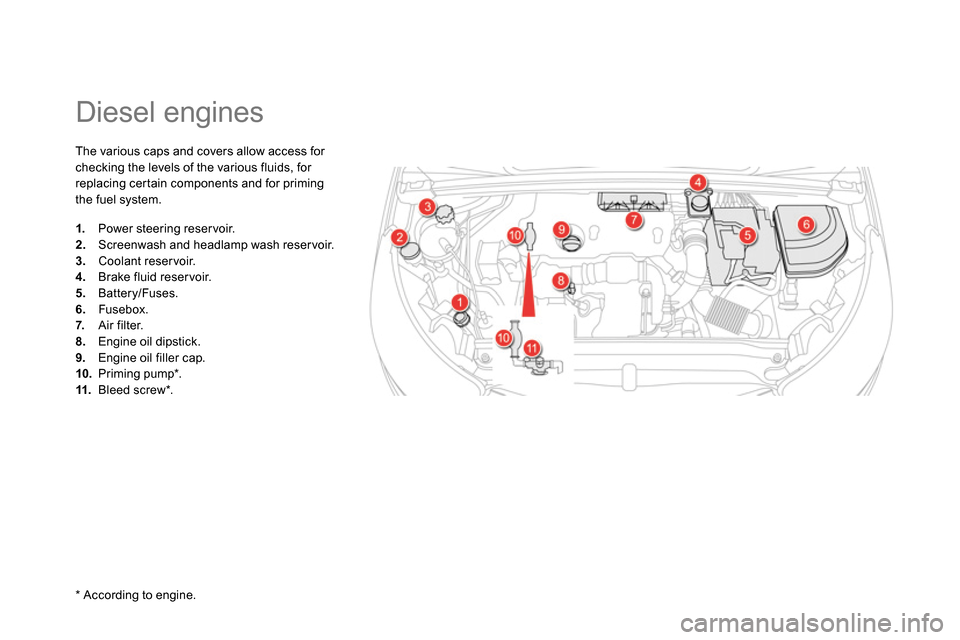
Diesel engines
The various caps and covers allow access for
checking the levels of the various fluids, for
replacing certain components and for priming
the fuel system.
1.
Power steering reservoir.
2.
Screenwash and headlamp wash reser voir.
3.
Coolant reservoir.
4.
Brake fluid reser voir.
5.
Battery/Fuses.
6.
Fusebox.
7.
Air filter.
8.
Engine oil dipstick.
9.
Engine oil filler cap.
10.
Priming pump * .
11.
Bleed screw * .
*
According to engine.
Page 241 of 400
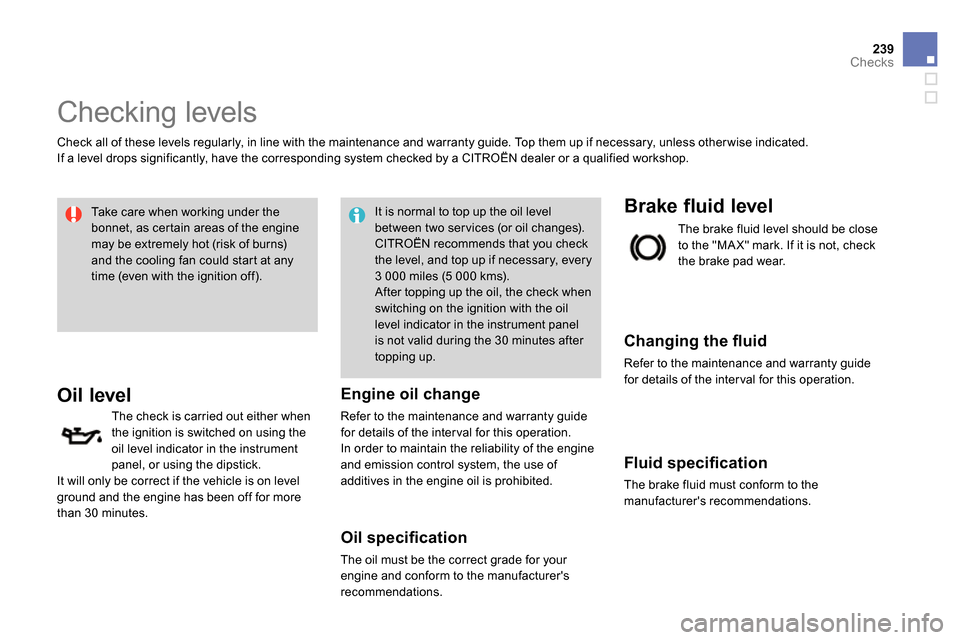
239Checks
Checking levels
Check all of these levels regularly, in line with the maintenance and warranty guide. Top them up if necessary, unless other wise indicated.
If a level drops significantly, have the corresponding system checked by a CITROËN dealer or a qualified workshop.
Oil level
Engine oil change
Refer to the maintenance and warranty guide
for details of the inter val for this operation.
In order to maintain the reliability of the engine
and emission control system, the use of
additives in the engine oil is prohibited.
Oil specifi cation
The oil must be the correct grade for your
engine and conform to the manufacturer's
recommendations.
Brake fluid level
Changing the fl uid
Refer to the maintenance and warranty guide
for details of the inter val for this operation.
Fluid specifi cation
The brake fluid must conform to the
manufacturer's recommendations.
The brake fluid level should be close
to the "MA X" mark. If it is not, check
the brake pad wear.
The check is carried out either when
the ignition is switched on using the
oil level indicator in the instrument
panel, or using the dipstick.
It will only be correct if the vehicle is on level
ground and the engine has been off for more
than 30 minutes.
Take care when working under the
bonnet, as certain areas of the engine
may be extremely hot (risk of burns)
and the cooling fan could start at any
time (even with the ignition off).
It is normal to top up the oil level
between two ser vices (or oil changes).
CITROËN recommends that you check
the level, and top up if necessary, every
3 000 miles (5 000 kms).
After topping up the oil, the check when
switching on the ignition with the oil
level indicator in the instrument panel
is not valid during the 30 minutes after
topping up.
Page 242 of 400
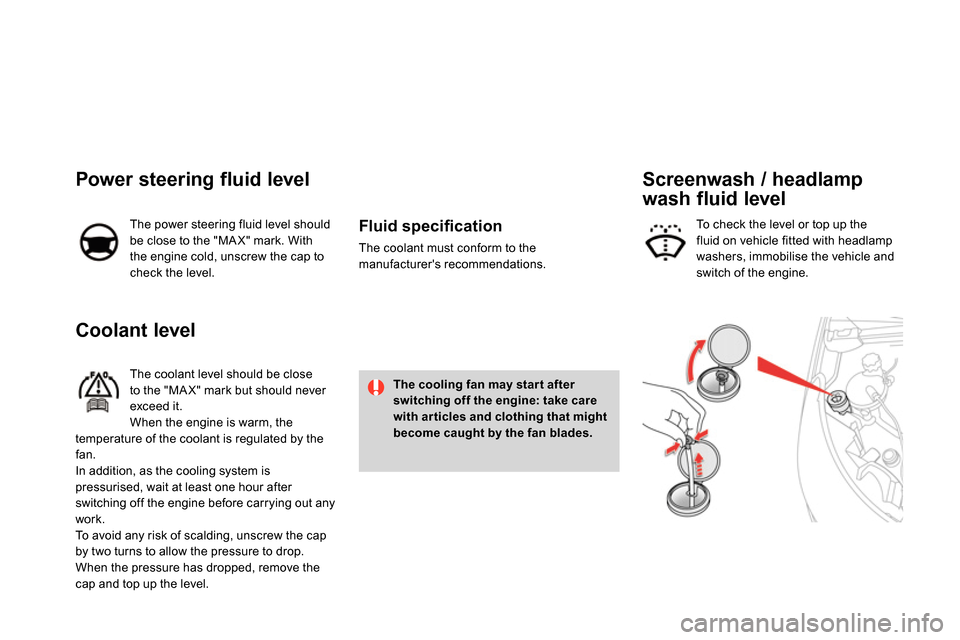
Coolant level
The coolant level should be close
to the "MA X" mark but should never
exceed it.
When the engine is warm, the
temperature of the coolant is regulated by the
fan.
In addition, as the cooling system is
pressurised, wait at least one hour after
switching off the engine before carrying out any
work.
To avoid any risk of scalding, unscrew the cap
by two turns to allow the pressure to drop.
When the pressure has dropped, remove the
cap and top up the level.
Fluid specifi cation
The coolant must conform to the
manufacturer's recommendations.
Power steering fluid level
The power steering fluid level should
be close to the "MA X" mark. With
the engine cold, unscrew the cap to
check the level. To check the level or top up the
fluid on vehicle fitted with headlamp
washers, immobilise the vehicle and
switch of the engine.
Screenwash / headlamp
wash fluid level
The cooling fan may star t after
switching off the engine: take care
with ar ticles and clothing that might
become caught by the fan blades.
Page 244 of 400
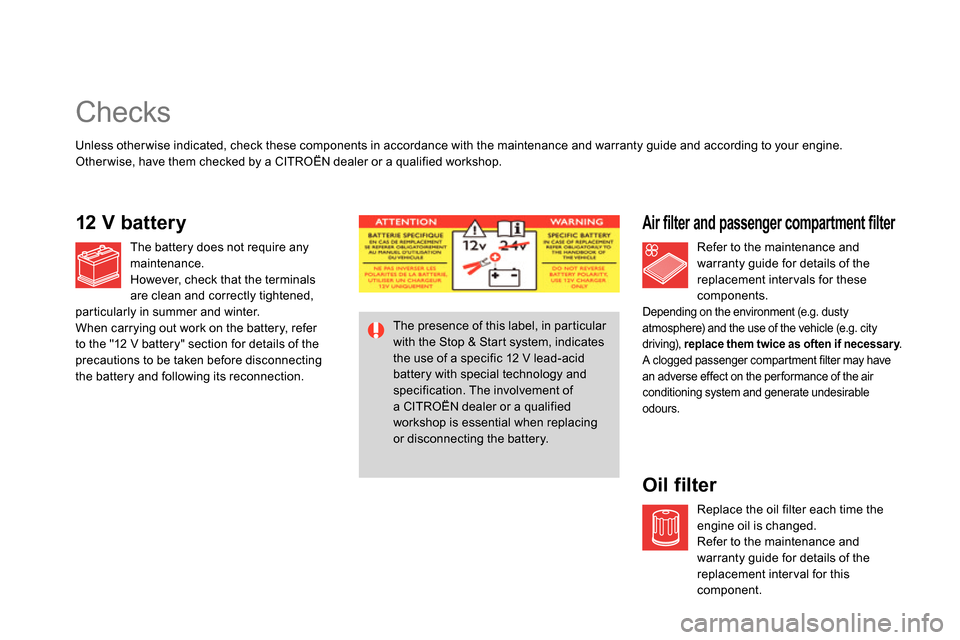
Checks
Air filter and passenger compartment filter
Oil filter
Unless other wise indicated, check these components in accordance with the maintenance and warranty guide and according to your engine.
Other wise, have them checked by a CITROËN dealer or a qualified workshop.
Refer to the maintenance and
warranty guide for details of the
replacement inter vals for these
components.
Depending on the environment (e.g. dusty
atmosphere) and the use of the vehicle (e.g. city
driving), replace them twice as often if necessar y
.
A clogged passenger compartment filter may have
an adverse effect on the per formance of the air
conditioning system and generate undesirable
odours.
Replace the oil filter each time the
engine oil is changed.
Refer to the maintenance and
warranty guide for details of the
replacement inter val for this
component.
The presence of this label, in particular
with the Stop & Start system, indicates
the use of a specific 12 V lead-acid
battery with special technology and
specification. The involvement of
a CITROËN dealer or a qualified
workshop is essential when replacing
or disconnecting the battery.
12 V battery
The battery does not require any
maintenance.
However, check that the terminals
are clean and correctly tightened,
particularly in summer and winter.
When carrying out work on the battery, refer
to the "12 V battery" section for details of the
precautions to be taken before disconnecting
the battery and following its reconnection.
Page 251 of 400
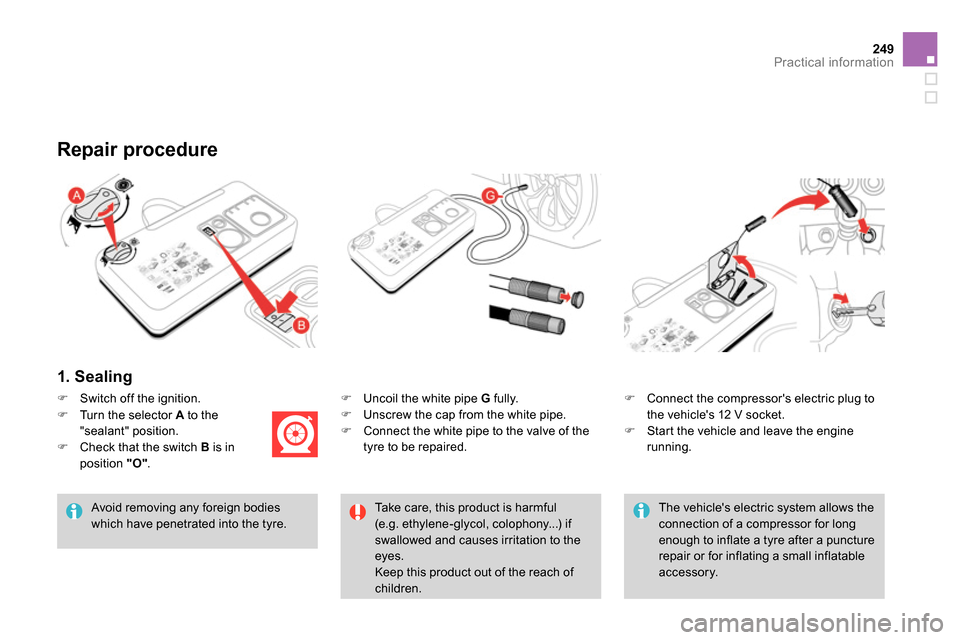
249Practical information
1. Sealing
Uncoil the white pipe G
fully.
Unscrew the cap from the white pipe.
Connect the white pipe to the valve of the
tyre to be repaired.
Repair procedure
Avoid removing any foreign bodies
which have penetrated into the tyre.
Connect the compressor's electric plug to
the vehicle's 12 V socket.
Start the vehicle and leave the engine
running.
Switch off the ignition.
Take care, this product is harmful
(e.g. ethylene-glycol, colophony...) if
swallowed and causes irritation to the
eyes.
Keep this product out of the reach of
children.
Turn the selector A
to the
"sealant" position.
Check that the switch B
is in
position "O"
.
The vehicle's electric system allows the
connection of a compressor for long
enough to inflate a tyre after a puncture
repair or for inflating a small inflatable
accessory.
Page 254 of 400
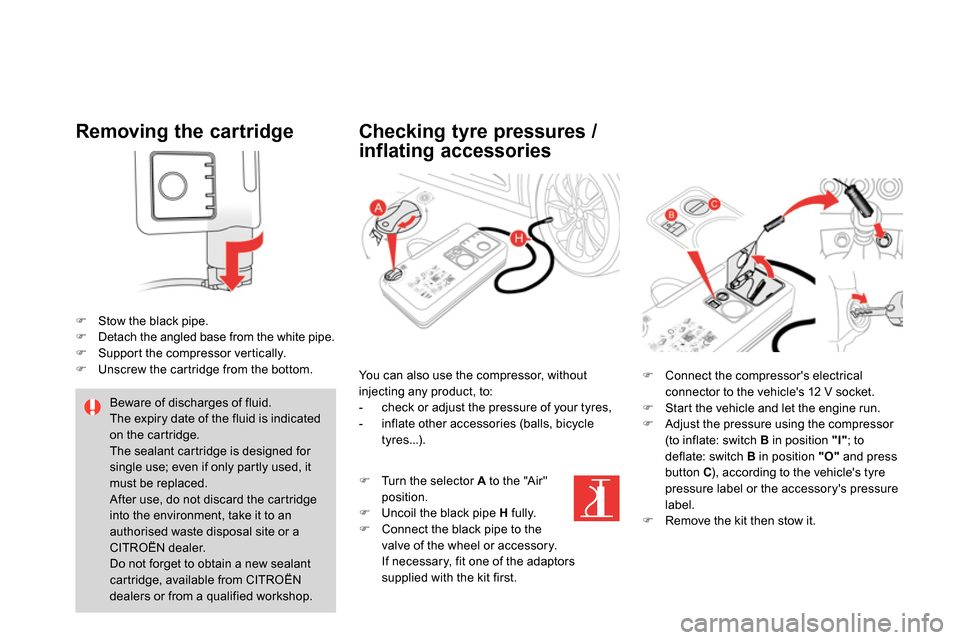
Removing the cartridge
Stow the black pipe.
Detach the angled base from the white pipe.
Support the compressor vertically.
Unscrew the cartridge from the bottom.
Checking tyre pressures /
inflating accessories
Beware of discharges of fluid.
The expiry date of the fluid is indicated
on the cartridge.
The sealant cartridge is designed for
single use; even if only partly used, it
must be replaced.
After use, do not discard the cartridge
into the environment, take it to an
authorised waste disposal site or a
CITROËN dealer.
Do not forget to obtain a new sealant
cartridge, available from CITROËN
dealers or from a qualified workshop.
You can also use the compressor, without
injecting any product, to:
- check or adjust the pressure of your tyres,
- inflate other accessories (balls, bicycle
tyres...).
Connect the compressor's electrical
connector to the vehicle's 12 V socket.
Start the vehicle and let the engine run.
Adjust the pressure using the compressor
(to inflate: switch B
in position "I"
; to
deflate: switch B
in position "O"
and press
button C
), according to the vehicle's tyre
pressure label or the accessory's pressure
label.
Remove the kit then stow it.
Turn the selector A
to the "Air"
position.
Uncoil the black pipe H
fully.
Connect the black pipe to the
valve of the wheel or accessory.
If necessary, fit one of the adaptors
supplied with the kit first.
Page 276 of 400
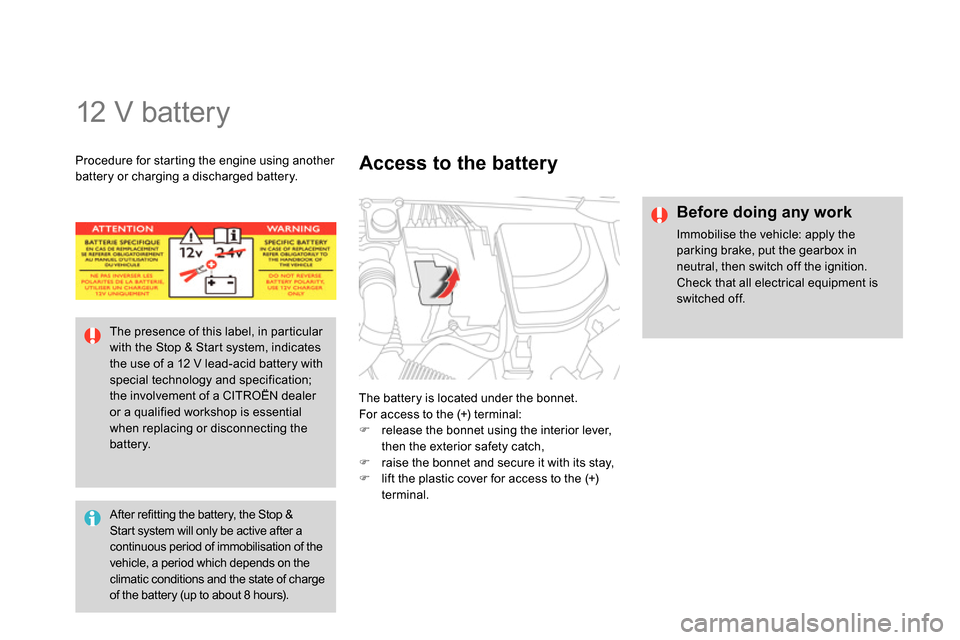
12 V battery
The battery is located under the bonnet.
For access to the (+) terminal:
release the bonnet using the interior lever,
then the exterior safety catch,
raise the bonnet and secure it with its stay,
lift the plastic cover for access to the (+)
terminal.
Access to the battery
After refitting the battery, the Stop &
Start system will only be active after a
continuous period of immobilisation of the
vehicle, a period which depends on the
climatic conditions and the state of charge
of the battery (up to about 8 hours).
The presence of this label, in particular
with the Stop & Start system, indicates
the use of a 12 V lead-acid battery with
special technology and specification;
the involvement of a CITROËN dealer
or a qualified workshop is essential
when replacing or disconnecting the
battery.
Before doing any work
Immobilise the vehicle: apply the
parking brake, put the gearbox in
neutral, then switch off the ignition.
Check that all electrical equipment is
switched off.
Procedure for starting the engine using another
battery or charging a discharged battery.
Page 277 of 400

275Practical information
Connect the red cable to the positive
terminal (+) of the flat battery A
, then to the
positive terminal (+) of the slave battery B
.
Connect one end of the green or black
cable to the negative terminal (-) of the
slave battery B
(or earth point on the other
vehicle).
Connect the other end of the green or black
cable to the earth point C
on the broken
down vehicle (or on the engine mounting).
Start the engine of the vehicle with the
good battery and leave it running for a
few minutes.
Operate the starter on the broken down
vehicle and let the engine run
.
If the engine does not star t straight away,
switch off the ignition and wait a few
moments before trying again.
Wait until the engine returns to idle then
disconnect the jump lead cables in the
reverse order.
Starting using another
battery
When your vehicle's battery is discharged, the
engine can be started using a slave battery
(external or on another vehicle) and jump lead
cables.
First check that the slave battery has a
nominal voltage of 12 V and a capacity
at least equal to that of the discharged
battery.
Do not try to start the engine by
connecting a battery charger.
Do not disconnect the (+) terminal when
the engine is running.
Before disconnecting the battery
Wait 2 minutes after switching off the ignition
before disconnecting the battery.
Close the windows and the doors before
disconnecting the battery.
Page 279 of 400
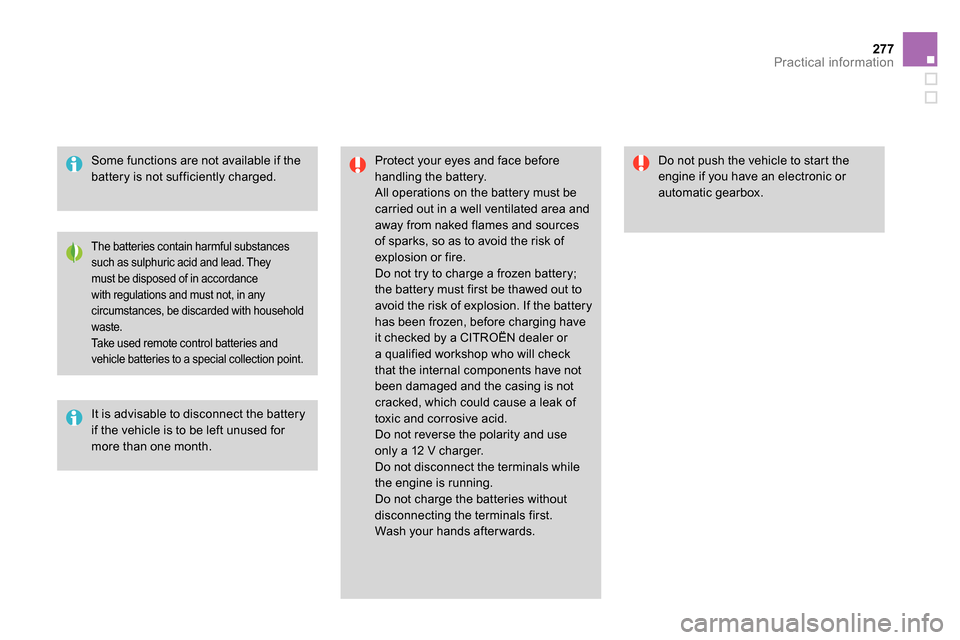
277Practical information
Some functions are not available if the
battery is not sufficiently charged.
Protect your eyes and face before
handling the battery.
All operations on the battery must be
carried out in a well ventilated area and
away from naked flames and sources
of sparks, so as to avoid the risk of
explosion or fire.
Do not try to charge a frozen battery;
the battery must first be thawed out to
avoid the risk of explosion. If the battery
has been frozen, before charging have
it checked by a CITROËN dealer or
a qualified workshop who will check
that the internal components have not
been damaged and the casing is not
cracked, which could cause a leak of
toxic and corrosive acid.
Do not reverse the polarity and use
only a 12 V charger.
Do not disconnect the terminals while
the engine is running.
Do not charge the batteries without
disconnecting the terminals first.
Wash your hands after wards.
It is advisable to disconnect the battery
if the vehicle is to be left unused for
more than one month.
The batteries contain harmful substances
such as sulphuric acid and lead. They
must be disposed of in accordance
with regulations and must not, in any
circumstances, be discarded with household
waste.
Take used remote control batteries and
vehicle batteries to a special collection point.
Do not push the vehicle to start the
engine if you have an electronic or
automatic gearbox.